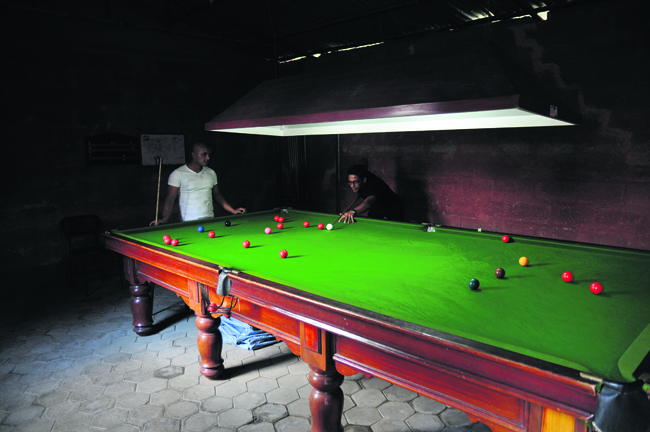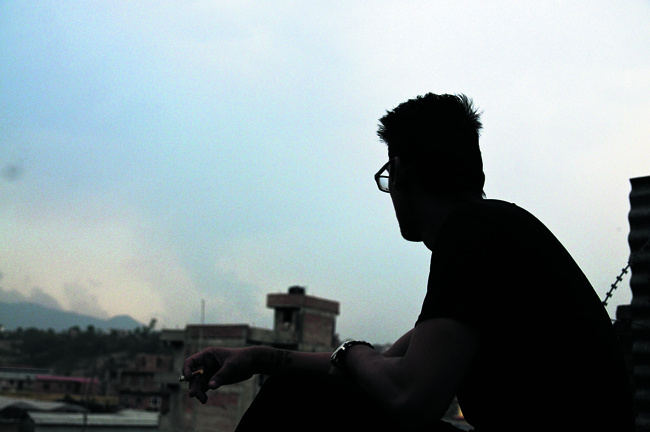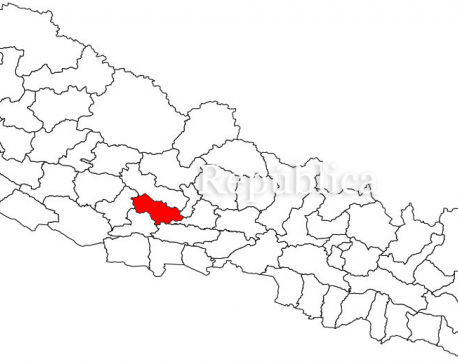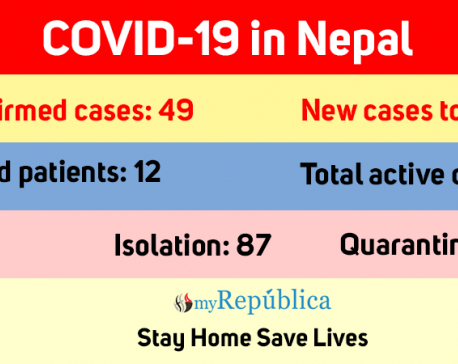
OR
Cover Story

“All it takes is a hello from a wrong friend from your previous circle on Facebook or even a bus that didn’t come on time and before you know it, you are back at it again.”
Petty thief, extortionist, drug dealer, KC claims to have done it all at one point. And the motive was pretty straight forward: To maintain his own high.
These candid confessions come from the same man who is now in charge of rehabilitating addicts at one of the better known treatment centers in the country. In fact in his cozy office at Maya Nepal, the drugs he so willing committed the varying degrees of crime for conveniently sit in a drawer, an arm’s length way, but KC isn’t bothered.
“10 years and still sober,” he says. However, his tone isn’t exactly one of triumph.
It’s taken a lot to reach this stage in life. The confessions continue – multiple arrests, more drugs, eloping with his then girlfriend, numerous rehab stints, abortion of his unborn child, some more drugs, and repeated entanglement with the law. KC doesn’t shy away from details. He too seems to be amazed that so much had happened to him even before he turned 26, which was when he made his first successful attempt at being sober.
Even though he had entered several rehabilitation treatment centers in the country and abroad before that point, in his opinion, he hadn’t quite hit his rock bottom yet. “The person, who wants to be sober, must feel the need to be sober. Too often that’s the difference between a successful and an unsuccessful rehabilitation stay,” shares KC.
So his all time low, while had a victorious start with him selling his father’s prized car for drug money and then using as well as selling the new haul from a posh hotel room with his friends, eventually he had to bear the consequences. His family relationships, his health, his bank account, the run-ins with law all turned sour. Feeling mercilessly trapped from all sides, KC says he knew then that he had to make a choice. He voluntarily stayed at Maya Nepal for almost a year.
These first hand experiences certainly come in handy while helping addicts or more so their families who walk in seeking the treatment center’s help. Maya Nepal tends to accommodate 50-60 people at a time. Though patients keep coming and leaving, they are regularly full to their capacity and KC cites that, over the years, he has seen change in the type of addiction present in our society.
“20 or even 10 years ago, hard drugs were more accessible. I was on heroin and so was everybody around me. You could get a proper fix for Rs 200 but that’s unimaginable these days,” shares KC.
Today, majority of the rehabilitation centers in and around the capital inform that the most common addiction present in our society is alcohol and weed (ganja). Pharmaceutical drugs make up the top three, closely followed by brown sugar.
Nabin Pant*, 25, shares his story. “It didn’t take long to go from a puff or two of weed a day to a pill or two during my early college days,” he says. In his words, the dealers easily came out of the woods once he began hanging out with the ‘right’ crowd. Apparently pharmacies near his home also easily handed them the pills they were looking for.
KC believes that some pharmacies have been known to act as enablers and support this kind of behavior once they identify an addict. They sell their medications at least at double the price rate but for students from middle class background like Pant, Rs 2000- Rs 2500 isn’t exactly a problem.
Pant explains initially he really didn’t understand the need for his first rehab stay or his second. He didn’t consider it a problem. He began his third stint just when he was starting brown sugar and even then, happily negotiated to join a boarding school in India only to get out of his third stint. In hindsight, he says he genuinely didn’t realize that he was addicted. He thought he could control the urges on his own.
However, his parents enrolled KC at Maya Nepal on the day he woke up on the stairs of his house under a blanket, his face all cut up, with blood marks but he didn’t have any recollection of how he got that way. He assumes his mother had covered him up.
Pant tries to explain, “When you are actively using drugs, you really don’t care about anything, not even yourself. You may be functioning but reality doesn’t exist either. Life is just one fix to another.” Today it’s been nine months of sobriety but he still can’t remember the details of that night.
Now he wishes he was aware about addiction. He believes that might help prevent many others from spiraling into the rabbit hole of addiction.
This has been Pant’s longest stint in rehab. Even though, as per the rule, you are required to stay for three months at Maya Nepal, he hasn’t been able to leave without his parents’ consent. KC though agrees with their decision. “As the gap between your use and sobriety increases, you will feel less tempted,” he says.
Pant admits to being slightly bored of the monotony and has already begun worrying about how he will start his life once out of rehab. Just last month, he had his very first home visit. He was allowed to leave rehab for 12 hours. He reveals he should consider it a success because he basically spent the time home browsing through the internet. However, it felt awkward and slightly unusual.
He talks about just how easy it is to fall back in the drug trap. “All it takes is a hello from a wrong friend from your previous circle on Facebook or even a bus that didn’t come on time and before you know it, you are back at it again. It’s what happened every single time.”
Indeed the after care is as important, if not more, as rehabilitation treatment. But there is no blueprint of such after care programs in Nepal. Though folks associated with rehabilitation care had come together around five years ago to build such a program, it eventually failed.
Thus centers like Maya Nepal either try to get their patients back to their studies and teach them some kind of skills or, more popularly, simply help them find jobs abroad so that they can begin anew without the old temptations or bad circle of friends.
KC is hopeful the latter will be the case for Bibek Amatya* as well. The 24-year-old is even currently taking his 12th grade exam by studying for the tests at the rehabilitation center itself.
Amatya seems determined and hopeful. Apparently his own family has been taken aback by the change in his personality. “Earlier I don’t even remember interacting with my family at all,” says Amatya “I used to weigh 56 kilos as well. Now I am 70 kilos and I listen and respond. It’s a different feeling altogether.”
These differences, for Amatya too, have been felt in mere eight months of his stay. The dangerous habit that, again like the others, had developed in college with weed and escalated interrupted a good deal of his past five years. Amatya reveals that the instructors at the center share anecdotes of some of his misbehavior that they had heard from his family. While he remembers some of it, he reveals that he didn’t have a clue about the others and the unease he feels about it is apparent.
According to KC, these sentiments especially among those who have stayed longer durations tend to be similar but still the reality out of the rehab often proves to be crueler. In his opinion, out of the 3000 patients that the center has treated, the number of those ex patients who continue to be off drugs is only in the hundreds.
“Sometimes we tell them not to get out of the house when it isn’t work or family obligation because it’s that dangerous. During the stint, we try and develop their will to stay clean, ask them to extend their stay if required, hook them up with a job or activity but still for some, relapse is just around the corner,” says KC.
*names changed
priyankagurungg@gmail.com


You May Like This

Seven-year-old boy beats COVID-19
GULMI, May 9: A seven-year-old boy has got over the novel coronavirus disease (COVID-19). Rajesh Raut of Madane Rural Municipality-1... Read More...

One more COVID-19 patient recovers
CHITWAN, April 25: Of the two patients undergoing treatment for COVID-19 at the Chitwan-based Bharatpur Hospital, one was discharged from... Read More...

PAC seeks progress report on CGT recovery from Ncell
KATHMANDU, March 1: The Public Accounts Committee (PAC) has decided to ask the government to furnish it progress report on recovering... Read More...





Just In
- CM Kandel requests Finance Minister Pun to put Karnali province in priority in upcoming budget
- Australia reduces TR visa age limit and duration as it implements stricter regulations for foreign students
- Govt aims to surpass Rs 10 trillion GDP mark in next five years
- Govt appoints 77 Liaison Officers for mountain climbing management for spring season
- EC decides to permit public vehicles to operate freely on day of by-election
- Fugitive arrested after 26 years
- Indian Potash Ltd secures contract to bring 30,000 tons of urea within 107 days
- CAN adds four players to squad for T20 series against West Indies 'A'













Leave A Comment